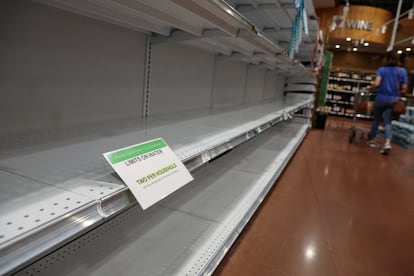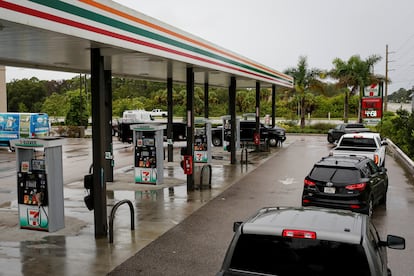Hurricane Ian barrels towards Florida after knocking out power grid in Cuba
Forecasters are warning about ‘catastrophic’ effects and a ‘life-threatening storm surge’ along the southwest coast of the US state
Forecasters on Wednesday reiterated warnings about the “catastrophic” potential of Hurricane Ian as it approached southwest Florida, where it was expected to make landfall in the evening.
The National Hurricane Center (NHC) issued a public advisory at 9am ET alerting about a “life-threatening storm surge expected along the southwest coast of Florida.” At that time the cyclone was around 60 miles west of Naples and packing winds of 155 mph (250 km/h), close to a Category 5, the highest on the hurricane intensity scale.
A storm surge watch was in effect for the Florida Keys in the south of the state, where there is “a danger of life-threatening inundation from rising water moving inland from the coastline.”
Around 193,000 homes in Florida had already lost power on Wednesday morning, according to the monitoring website Poweroutage.us

The hurricane alert affects most of the western coast of Florida, including Tampa Bay, home to the state’s third-largest city, Tampa, with a population of 335,000. The NHC was expecting the eye of the hurricane to reach the coast on Wednesday and cross Florida diagonally to the northeast. Forecasts suggest that it could become a Category 4 hurricane before making landfall, packing sustained winds of 131 to 155 mph (210 to 250 km/h).
On Tuesday afternoon Tampa International Airport, located near the bay, suspended operations due to the risk of high winds and floods. Smaller airports in the state also announced a halt on flights, although Miami’s remained operational.
Several counties have enacted mandatory evacuation from coastal areas. Others have also made non-binding recommendations to evacuate at-risk areas. US President Joe Biden held telephone calls on Tuesday with the mayors of Tampa, St. Petersburg and Clearwater to discuss preparations for the potential impact of Hurricane Ian, the White House said in a statement.

Biden declared an emergency on Saturday affecting numerous counties in Florida. This move authorizes the Department of Homeland Security and the Federal Emergency Management Agency (FEMA) to coordinate all disaster relief efforts and provide appropriate assistance.
Most hurricanes usually reach Florida along the eastern coast, but this one will mainly affect the western part of the state. The most memorable ones in Florida history are those of 1848 and 1921, which had devastating effects and even redefined the geography of Tampa Bay. Flooding in 1921 raised the water level in excess of three meters, affecting the city center and destroying a good many coastal structures. The most recent hurricane to hit the western coast of Florida was Charley in 2004, which hit Punta Gorda and Port Charlotte, just south of Tampa. In 2018 Hurricane Michael affected the northern coast.
Blackout in Cuba
Over 11 million Cubans were left in the dark on Tuesday when the national electricity system collapsed due to damage caused by Hurricane Ian, and 24 hours later they were still in the same situation, with no information about when the service would be restored. The Category 3 storm packed winds of 125 mph (200 km/h) as it passed through the island’s westernmost province, Pinar del Río.
A man and a woman were reported dead in Pinar del Río after their homes collapsed, according to the local newspaper Escambray.
There was also serious damage from wind and flooding in the west, where numerous communities were isolated on Tuesday due to downed trees and power poles. The effects on agriculture have been described as “severe” in Pinar del Río, including in the tobacco-growing areas, one of the country’s main exports. No official damage assessment has been provided yet, nor a fatality count.
Although the cyclone did not fully affect the island’s most important economic centers, the capital city of Havana was in chaos in the midst of the unexpected blackout. Many houses had partially or fully collapsed, and roads were blocked by fallen trees. There has been extensive damage and flooding in western coastal areas, where some localities have been cut off from the rest of the country.
Cuban authorities issued a brief note stating that due to “exceptional conditions” that could last until Wednesday or beyond, there would be no electricity supply in the country.
President Miguel Díaz-Canel visited the most affected areas in the west and said that all available resources would be used to repair the damage. Besides the blackout, many parts of the country lost cellphone connection and gas service for hours.
The collapse of the national electricity system caught residents of Havana as well as those in central and eastern Cuba by surprise. Never before had a hurricane caused the complete collapse of the power grid, and it comes at a time of crisis due to poor maintenance of the country’s thermoelectric plants, which break down daily and cause power cuts that sometimes exceed 12 hours a day.
For months, Cuba has been suffering a serious economic crisis and a general shortage of supplies, forcing Cubans to live from day to day and making it almost impossible to stock up on food and supplies against a natural disaster of this magnitude. Electricity, gas and water are unavailable in many homes, and the few perishable food items that people may be keeping in store could now spoil. Restoring power has become the country’s top priority.
The situation in some western locations has been described as dramatic. In Pinar del Río, more than 50,000 Cubans have been taken to state-run centers or relocated to the homes of family and friends.
“We are in the dark. The noise and the wind shocks are infernal. It stopped raining a while ago. The wind is constant and from time to time increases in intensity. It is as if everything was shaking... When the wind picks up, we close our eyes and press the eyelids tight, as if trying to hold on to the things around us,” observed Pinar del Río writer Nelson Simón.
Tu suscripción se está usando en otro dispositivo
¿Quieres añadir otro usuario a tu suscripción?
Si continúas leyendo en este dispositivo, no se podrá leer en el otro.
FlechaTu suscripción se está usando en otro dispositivo y solo puedes acceder a EL PAÍS desde un dispositivo a la vez.
Si quieres compartir tu cuenta, cambia tu suscripción a la modalidad Premium, así podrás añadir otro usuario. Cada uno accederá con su propia cuenta de email, lo que os permitirá personalizar vuestra experiencia en EL PAÍS.
¿Tienes una suscripción de empresa? Accede aquí para contratar más cuentas.
En el caso de no saber quién está usando tu cuenta, te recomendamos cambiar tu contraseña aquí.
Si decides continuar compartiendo tu cuenta, este mensaje se mostrará en tu dispositivo y en el de la otra persona que está usando tu cuenta de forma indefinida, afectando a tu experiencia de lectura. Puedes consultar aquí los términos y condiciones de la suscripción digital.
More information
Últimas noticias
Welcome to the post-religion era: The idea of Christianity as the absolute truth has become obsolete
‘I thought you would like it’: The risky sexual practice popularized by TV shows and TikTok
The digitalization of tourism: ‘They promise experiences and gave us the worst possible one’
Mexican peso defies uncertainty with forecasts of a new period of stability in 2026
Most viewed
- Sinaloa Cartel war is taking its toll on Los Chapitos
- Oona Chaplin: ‘I told James Cameron that I was living in a treehouse and starting a permaculture project with a friend’
- Reinhard Genzel, Nobel laureate in physics: ‘One-minute videos will never give you the truth’
- Why the price of coffee has skyrocketed: from Brazilian plantations to specialty coffee houses
- Silver prices are going crazy: This is what’s fueling the rally









































